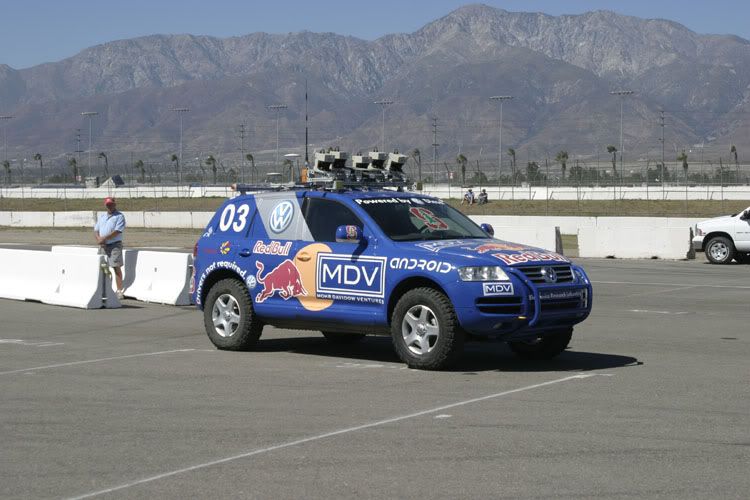Volkswagen and Stanford's Robotic Ground Vehicle Advances to National Championship
Posted by Lorenzo at 5:22 pm
Text from and photos Volkswagen of America.

 Volkswagen Touareg, aka “Stanley,” to embark on rigorous course for $2 million prize
Volkswagen Touareg, aka “Stanley,” to embark on rigorous course for $2 million prize
FONTANA, Calif. -- With the technological support of the Volkswagen Electronics Research Laboratory (ERL), Stanford University’s robotic Volkswagen Touareg, known as Stanley, has advanced to the 2005 DARPA Grand Challenge in Primm, Nev., this Saturday. Stanley went head-to-head with 39 other autonomous vehicles during the National Qualification Event last week for a chance at one of the 20 finalist spots. During four qualifying rounds at the California Speedway, Stanley was the only vehicle to avoid all obstacles.
The Grand Challenge, sponsored by the Defense Advanced Research Project Agency (DARPA), a division of the U.S. Department of Defense, aims to advance autonomous vehicle technology. The DARPA Grand Challenge puts 20 robotic ground vehicles to the test over 175 miles of rough desert roads, mountain trails, dry lake beds and tunnels, using only onboard sensors and navigation equipment. Human assistance is prohibited. DARPA will award $2 million to the team whose vehicle successfully completes the route the fastest within a 10-hour time period.
“It is extremely rewarding to the entire team that Stanley has made it to the DARPA Grand Challenge,” said Sebastian Thrun, director, Stanford Artificial Intelligence Laboratory. “This event contributes to significant advancements in vehicle technology, and we’re pleased to be a part of it.”
“It has been exciting and challenging to prepare the Touareg for this,” said Steve Keyes, General Manager of Public Relations at Volkswagen. “The lessons Volkswagen learned in building this highly complex vehicle will ultimately benefit our customer, as we’ll apply this knowledge to make Volkswagen cars safer, more comfortable, and exciting to drive.”
Stanley is built from a stock, Diesel-powered Volkswagen Touareg R5 modified with full-body skid plates and a reinforced front bumper. It is actuated by a drive-by-wire system developed by the ERL. All processing takes place on 6 Pentium M computers and measurements are incorporated from GPS, a 6DOF inertial measurement unit, and wheel speed for pose estimation.
Stanley and the other 19 finalists will embark on a yet-unknown course beginning and ending in Primm, Nev., on Saturday.
Founded in 1955, Volkswagen of America, Inc. is headquartered in Auburn Hills, Michigan. It is a subsidiary of Volkswagen AG, headquartered in Wolfsburg, Germany. Volkswagen is one of the world’s largest producers of passenger cars and Europe’s largest automaker. Volkswagen of America and its affiliates employ approximately 3,000 people in the United States and are responsible for the sale and service of Audi, Bentley, and Volkswagen products through retail networks comprising in total more than 900 independent U.S. dealers.

 Volkswagen Touareg, aka “Stanley,” to embark on rigorous course for $2 million prize
Volkswagen Touareg, aka “Stanley,” to embark on rigorous course for $2 million prizeFONTANA, Calif. -- With the technological support of the Volkswagen Electronics Research Laboratory (ERL), Stanford University’s robotic Volkswagen Touareg, known as Stanley, has advanced to the 2005 DARPA Grand Challenge in Primm, Nev., this Saturday. Stanley went head-to-head with 39 other autonomous vehicles during the National Qualification Event last week for a chance at one of the 20 finalist spots. During four qualifying rounds at the California Speedway, Stanley was the only vehicle to avoid all obstacles.
The Grand Challenge, sponsored by the Defense Advanced Research Project Agency (DARPA), a division of the U.S. Department of Defense, aims to advance autonomous vehicle technology. The DARPA Grand Challenge puts 20 robotic ground vehicles to the test over 175 miles of rough desert roads, mountain trails, dry lake beds and tunnels, using only onboard sensors and navigation equipment. Human assistance is prohibited. DARPA will award $2 million to the team whose vehicle successfully completes the route the fastest within a 10-hour time period.
“It is extremely rewarding to the entire team that Stanley has made it to the DARPA Grand Challenge,” said Sebastian Thrun, director, Stanford Artificial Intelligence Laboratory. “This event contributes to significant advancements in vehicle technology, and we’re pleased to be a part of it.”
“It has been exciting and challenging to prepare the Touareg for this,” said Steve Keyes, General Manager of Public Relations at Volkswagen. “The lessons Volkswagen learned in building this highly complex vehicle will ultimately benefit our customer, as we’ll apply this knowledge to make Volkswagen cars safer, more comfortable, and exciting to drive.”
Stanley is built from a stock, Diesel-powered Volkswagen Touareg R5 modified with full-body skid plates and a reinforced front bumper. It is actuated by a drive-by-wire system developed by the ERL. All processing takes place on 6 Pentium M computers and measurements are incorporated from GPS, a 6DOF inertial measurement unit, and wheel speed for pose estimation.
Stanley and the other 19 finalists will embark on a yet-unknown course beginning and ending in Primm, Nev., on Saturday.
Founded in 1955, Volkswagen of America, Inc. is headquartered in Auburn Hills, Michigan. It is a subsidiary of Volkswagen AG, headquartered in Wolfsburg, Germany. Volkswagen is one of the world’s largest producers of passenger cars and Europe’s largest automaker. Volkswagen of America and its affiliates employ approximately 3,000 people in the United States and are responsible for the sale and service of Audi, Bentley, and Volkswagen products through retail networks comprising in total more than 900 independent U.S. dealers.











<< Home